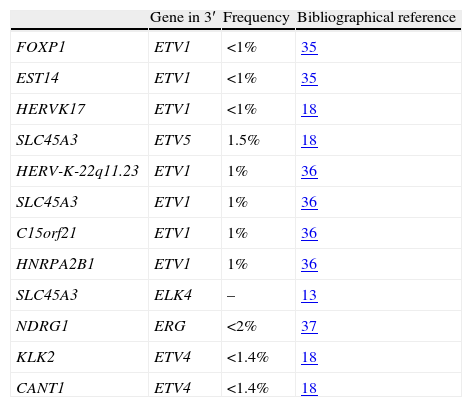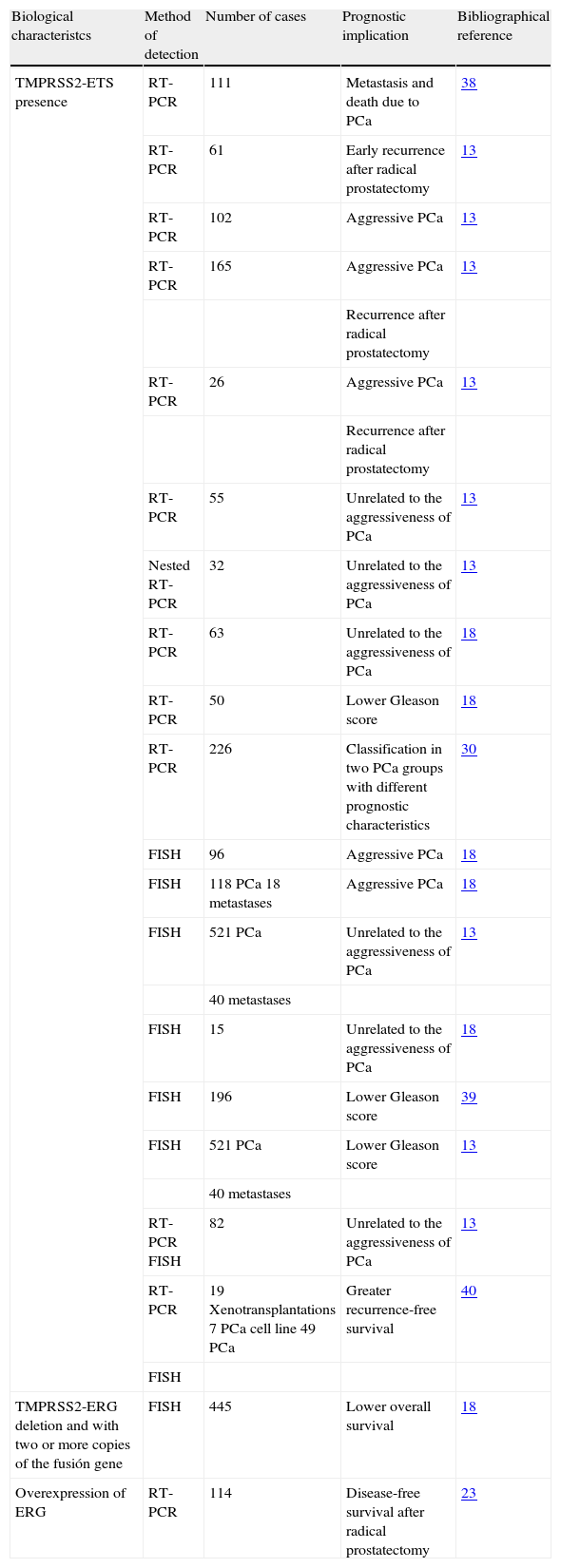TMPRSS2-ETS fusion gene rearrangements constitute a very common and specific alteration in prostate cancer cells. These genetic alterations lead the overexpression of ETS genes which encode the E26 family of transcription factors involved in cell proliferation. Of this family, the ERG oncogene is overexpressed in almost 50% of prostate cancer cases.
Evidence synthesisTMPRSS2-ERG overexpresses ERG through an androgen-mediated response. Structurally, the rearrangement is due to interstitial deletion and to a lesser extent to reciprocal translocation and plays a key role in cellular metabolism. Almost all fusion gene transcripts produce a truncated ERG protein and the presence of a specific isoform of this gene suggests the clonality of the tumor; hence, metastasis shares the fusion gene status of their primary lesion. Although the prognostic implications of TMPRSS2-ERG have not been fully elucidated, they constitute a field of great diagnostic potential and, therefore, the development of techniques to identify and to analyze the presence and characteristics of this gene in a non-invasive fashion deserves great interest in this area. Currently, there is evidence supporting the hypothesis that the presence of fusion gene differentiates two molecular groups within prostate cancer with a differential behavior making the fusion gene a potential therapeutic target. In this regard, the use of anti-HDAC (trichostatin), antagonists of estrogen receptor alpha and abiraterone acetate have shown promising results.
ConclusionsThis review describes the great potential offered by the investigation of fusion genes in PC and the need for further studies.
Los reordenamientos TMPRSS2-ETS constituyen una alteración específica y frecuente en tumores prostáticos que conlleva la sobreexpresión de los genes ETS que codifican para la familia E26 de factores de transcripción, promoviendo la proliferación celular. De entre estos ERG sobreexpresa en casi el 50% de los carcinomas prostáticos.
Síntesis de evidenciaTMPRSS2-ERG sobreexpresa a ERG en respuesta a andrógenos. Estructuralmente este reordenamiento se debe a una deleción intersticial y, en menor medida, a una translocación recíproca, y tiene un papel clave en el metabolismo celular. Casi todos los transcritos del gen de fusión producen una proteína ERG truncada, y la presencia de una determinada isoforma de este gen indica la clonalidad del tumor, de modo que la metástasis comparte isoforma de TMPRSS2-ERG con su localización primaria. Aunque las implicaciones pronósticas de TMPRSS2-ERG no están totalmente elucidadas se considera un campo de gran potencial diagnóstico, por lo que el desarrollo de técnicas que permitan determinar la presencia y características de este gen de forma no invasiva es muy interesante. La presencia del gen de fusión constituye dos grupos moleculares dentro del CaP con un comportamiento evolutivo claramente diferencial, lo que hace que farmacológicamente el gen de fusión constituya una diana terapéutica potencial. En este sentido, el uso de fármacos anti-HDAC (tricostatina), antagonistas del receptor de estrógenos alfa y acetato de abiraterona han mostrado resultados prometedores.
ConclusionesEsta revisión expone el gran potencial que representa la investigación de los genes de fusión en el CaP y la necesidad de profundizar en su estudio.











